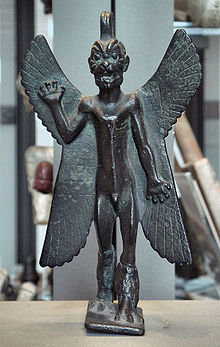- Pazuzu
-
Pazuzu ist ein Dämon der sumerischen und akkadischen Mythologie.
Mythologie
Er galt als Personifikation des Südostwinds und brachte Pest, Fieber und Kälte. Er wird als Sohn des Gottes Hanbi bezeichnet und wird mit hundeähnlichem Kopf, den Füßen eines Adlers, schlangenköpfigem Penis, einem Skorpionsschwanz und vier Flügeln dargestellt. Oft weist eine Hand nach oben, die andere nach unten, was in hermetischen Spekulationen der Neuzeit als Hinweis auf den Grundsatz: „Wie oben, so unten“ gedeutet wurde.
Er wird als Gegner Lamaštus beschrieben, die Mutter und Kind im Kindbett bedroht, und wurde daher von diesen auf Schutzamuletten dargestellt getragen.
Popkultur
Pazuzu ist auch der Name des Dämons, der im Film Der Exorzist Besitz von einem jungen Mädchen ergreift. In einer der ersten Einstellungen ist auch eine Statue von ihm zu sehen. Diese Statue wurde später von der Band Gorillaz wieder verwendet.
Im zweiten Band der Comic-Serie Adeles ungewöhnliche Abenteuer des französischen Zeichners Jacques Tardi wird ein bizarrer Pazuzu-Kult im Paris der Jahrhundertwende aufgedeckt.
In der US-amerikanischen Cartoonserie Futurama besitzt Prof. Hubert Farnsworth einen fliegenden Wasserspeier, der auf den Namen Pazuzu hört.
Der Name Pazuzu wird auch von der polnischen Death-Metal-Band Behemoth als ein Titel auf dem Album "The Apostasy" aufgegriffen.
Weblinks
Wikimedia Foundation.

